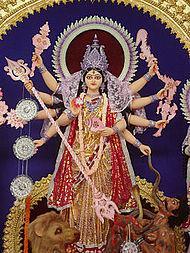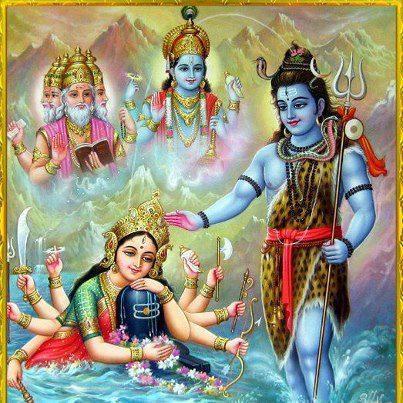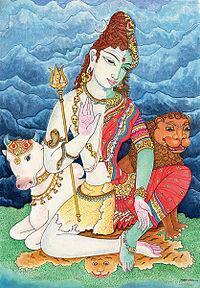PARVATI
Contents
· Introduction
· In Sanskrit literature
· Nomenclature
· Past life
· Birth and early life
· Shiva in penance
· Sage Narada’s arrival
· Further events
· The burning of Kamadeva
· Parvati’s penance
· Marriage
· Parvati’s knowledge
· Symbolism
· In Arts
· In Rosaries
· In Numismatics
· Festivals dedicated to Parvati
· Temples
· Scriptures
· Conclusion
Introduction


Shakti, the mother goddess in Hinduism, has many aspects and attributes. In Hindu mythology, each aspect is expressed by a given name giving her 108 names in all and she forms the trinity of Hindu Goddesses along with Goddess Lakshmi (Goddess of wealth and prosperity) and Goddess Saraswathi (Goddess of learning and knowledge). The gentle and nurturing aspect of Shakti is goddess Parvati. She is the Hindu Goddess of fertility, love and devotion. She is the consort of Lord Shiva, one of the trinity who is the regenerator and destroyer of the universe. She represents the power and recreative energy of Lord Shiva and symbolises the Prakriti aspect or the primal cause of all action and bondage that connects all beings. The story of Parvati is narrated by Vyasa in the Shiva Purana. Kalidasa in his great poem Kumara Sambhava has narrated her story poetically and beautifully. Among the other books on her is Girija Kalyana written by Kannada poet Harihara which is a mixture of prose and verse.

In Sanskrit literature
The earliest name of Parvati appears in the Hamsa Upanishad (Yoga/Shukla Yajurveda), the epics Ramayana and Mahabharata and the Puranas. Parvati appears as Uma and Ambika in the Talavakara Upanishad and as Uma Haimavathi in the Kena Upanishad. She appears as the Prakriti power of the Supreme Godhood who reveals the knowledge of the Supreme Brahman to Indra, Agni and Vayu. It is said that just as Shiva is said to be a combination of the Vedic Gods Agni and Rudra, Parvati is a combination of their wives. This is the reason for her having a fair, benign and calm disposition on one side and being portrayed as dark and ferocious on the other side.
Nomenclature
In Hindu literature, Parvati is known by many names. As daughter of King Himavat Parvat she is known as Parvati, as Nagaja, Shailaja, Adrija or Shailaputri ( Daughter of the Mountains), Haimavathi (daughter of Himavan), Girija or Girijaputri (daughter of the King of mountains). The Lalitha Sahasranama contains a list of 1000 names of Parvati as Goddess Lalitha Parmeshwari. Parvati was earlier born as Sati and in the Harivamsa she is referred to as Aparna (one who took no sustenance) and Uma (tranquillity, bright, mother, lady of the mountains), Ambika (dear mother), Mata (revered mother), Maheshwari (great Goddess), Bhairavi (ferocious), Shivaradni (Queen of Shiva), Bhavani (fertility and birthing or wife of Bhava or Shiva), Durga (invincible), Kamakshi ( Goddess of fertility, Annapurna (Goddess of food and nourishment), Gauri (fair one), Kali or Shyama (dark one), Eshwari (wife of Ishwara), Sarvamangala (source of all auspiciousness) and many other names.
Past Life
Goddess Parvati in her past life was Sati, the daughter of Daksha, who self-immolated herself as her father had insulted her husband Lord Shiva and she could no longer bear the ignominy and disrespect her father heaped on her and her husband. She was later reborn as Goddess Parvati.

Birth and Early life
The King of the Himalayas was King Himavat and his wife was Menadevi. They wished to have a daughter with beauty, character and wisdom hence both of them propitiated Goddess Shakti. Their wish was granted and Menadevi gave birth to a beautiful child. Legends state that after the birth, the child did not react to her surroundings nor drink milk but at the advice of the family preceptor Sage Gargamuni, an idol of Shiva was brought to the child and immediately the child gurgled happily and drank milk too. Everyone was stunned at this devotion to Shiva from such a young age. She was named Parvati and the first name she is said to have uttered was the name of Shiva. As she grew up she would be absorbed in thoughts of Shiva and would worship him on the sandy banks of the river Ganga. She soon grew up to be a graceful, pure and beautiful young woman.
Shiva in penance
After the death of his beloved Sati, Shiva had immersed himself in solitude and penance. Giving up his palace at Mount Kailas and in search of a suitable place for penance, Shiva had come to a sacred spot called Gangavatara on the Himalayan slopes where he went into deep meditation.
Sage Narada’s arrival
When Parvati reached marriageable age, King Himavat began contemplating on a suitable groom for her. He felt that since his daughter was always immersed in contemplation of Shiva, He would be the ideal groom for her. But he did not know how to approach Lord Shiva. One day Sage Narada came to his kingdom. The King and Queen bowed and welcomed him hospitably. The King expressed his thoughts to Narada who explained to them the story of Parvati’s previous life and the circumstances leading to her present birth. He then blessed Parvati and advised her that the Lord could not be won by beauty and grace but by piety, devotion and worship alone. Parvati was thrilled to hear Narada’s words. Her only desire throughout her life had been to spend it in contemplation and service of the Lord. She had heard that Lord Shiva was in penance at a place close by to her kingdom. Himavat decided to take her with him and approach Shiva. So saying, they left the palace and went to see him. When Parvati approached Shiva along with her father with a heart heavy with love and devotion, Lord Shiva opened his eyes and requested Himavat to see that he would be undisturbed from the people in the town, so that he could continue his penances uninterruptedly. He asked him to take back his daughter as he was an ascetic and did not need the service of any woman. But Himavat pleaded with Shiva on Parvati’s behalf and finally Shiva agreed to her service. Shiva then continued his penances while Himavat left Parvati behind and returned to the palace.
Further Events
Everyday Parvati bathed and washed Shiva’s feet with waters from the holy Ganges, worshipped and served him dutifully. But Shiva was unaffected by her and continued his contemplation and penances. This worried the Gods as they were being harassed by an evil demon named Tarakasura, who had obtained boons from Brahma that he would become all powerful and no one could destroy him except a son born to Shiva. He felt that as Shiva was an ascetic and would never marry, such a probability would never arise and he would remain invincible. So he began killing people, destroying hermitages and creating havoc everywhere. The Gods were worried and did not know how to bring Shiva out of his meditation and marry Parvati. They then decided to bring Lord Kamadeva and his consort Rati Devi to disturb Shiva’s meditation. Kamadeva knew the perils faced by him on deliberately awakening the Lord but for the sake of the higher good of mankind and the welfare of the world, he decided to proceed to awaken Shiva.
The burning of Kamadeva
Kamadeva and Rati Devi entered Shiva’s penance grove. Parvati was in attendance serving Shiva whole heartedly. Kamadeva then released his arrows on Shiva and Shiva stopped his meditation and glancing at Parvati fell in love with her. But Shiva’s tapas was broken and furious with Kamadeva, he opened his third eye and reducing him to ashes, Shiva then disappeared. Seeing her husband burnt to ashes, Rati Devi fainted and when she gained consciousness she begged Parvati to help her. Parvati blessed her that she would definitely regain her lost husband in her next birth. Parvati was saddened that Shiva had left her and vanished without a trace. But Sage Narada arrived and encouraged her to continue her penances in the same place where Shiva was meditating. He taught her the Shiva Panchakshari Mantra and blessed her with success in her endeavours.
Parvati’s penance
Parvati began rigorous penances and unmindful of heat, cold, rain and wind she focussed her mind completely on Lord Shiva. In the early , she lived on fruits but later on she conquered hunger and thirst and lived only on air. The heat generated by her tapas began to burn up the earth. All the Gods prayed to Lord Shiva to fulfil her desire and relieve the earth of its suffering. But Shiva wanted to test her and sent the Saptarishis to test her determination. The sages approached her and tried to undermine her resolve but she was undaunted. She said that she could never contemplate anyone else other than Shiva. The sages then pleased with her firm resolve returned to Lord Shiva and praised her persistence. Now Shiva felt that he himself should test her. Disguised as a Brahmin youth he approached her and tried to dissuade her by criticising Shiva’s appearance and demeanour. But Parvati was furious and could speak only sweet and gentle words about Shiva. Finally moved by her love and devotion, Shiva agreed to marry her. Parvati then requested him to approach her father and ask for her hand as befitting the right norms. She then requested Shiva to bless Rati Devi and Shiva declared that in this birth even without a form she and Kamadeva would be united together and Kamadeva would be reborn in his next birth as Krishna’s son Pradyumna when she would be reunited with him. Parvati then returned to her kingdom to the great joy of her parents on the successful completion of her mission.

Marriage
Subsequently Shiva sent the Saptarishis with his proposal to King Himavat who joyfully accepted. He sent for Vishwakarma, the Divine architect who built a beautiful marriage assembly hall where the wedding of Shiva and Parvati was performed with great pomp and splendour. The Gods rejoiced at this noble event and later Kartikeya and Ganesha were born. Kartikeya destroyed Tarakasura and re-established righteousness in the world. Ganesha was the dispeller of ignorance and brought knowledge and light to the world.
Parvati’s knowledge
Parvati is said to have learnt the Sanskrit language and grammar from Shiva known as the famous ‘Maheshwara Sutras’ later known as Panini’s grammar as it was publicised by Sage Panini. Similarly she also learnt other branches of knowledge like dance, painting, architecture, astrology, magic and many others including stories of creation, epics like Adhyatma Ramayana, Panchatantra and so on which was later narrated by Parvati to others.
Symbolism
 Parvati takes on a number of names and forms at different times and is generally represented by Yoni (womb) and Shiva as Linga, both of them representing the origin, source and regenerative power of the universe. She is the Universal mother who creates and nourishes but also destroys and protects. She symbolises the virtues of fertility, marital bliss, devotion to spouse, power and asceticism. The Thandava dance of Shiva and Parvati where Shiva is violent and destructive while Parvati provides calm and creative support symbolises the cosmic cycles of creation and destruction. The Ardhanarishwara is depicted as half male, half female and represents the synthesis of the inseparable Purusha (Shiva) and Prakriti (Parvati). It represents the union and interdependence of the male and female energies in the regeneration and recreation of all life.
Parvati takes on a number of names and forms at different times and is generally represented by Yoni (womb) and Shiva as Linga, both of them representing the origin, source and regenerative power of the universe. She is the Universal mother who creates and nourishes but also destroys and protects. She symbolises the virtues of fertility, marital bliss, devotion to spouse, power and asceticism. The Thandava dance of Shiva and Parvati where Shiva is violent and destructive while Parvati provides calm and creative support symbolises the cosmic cycles of creation and destruction. The Ardhanarishwara is depicted as half male, half female and represents the synthesis of the inseparable Purusha (Shiva) and Prakriti (Parvati). It represents the union and interdependence of the male and female energies in the regeneration and recreation of all life.
In Arts
The story of Shiva and Parvati is explored and expressed in various arts ranging from sculpture to dance as for example Daksha Yagam which is choreographed as a dance drama in Kathakali with many stories of Shiva- Parvati interwoven in them.
In Rosaries
The Gauri Shankar bead is a Rudraksha bead formed naturally from the seeds of a tree in India. Two seeds of this tree sometimes naturally fuse together and are considered highly auspicious symbols of Shiva and Parvati. These seeds are strung together to form Malas for meditation in Shaivism.
In Numismatics
Ancient coins in the Harshavardhan era and Kushan era show Parvati and Shiva on a bull or Parvati holding a flower with the reverse of the coin showing the Brahmi script.
Festivals dedicated to Parvati
Teej – This festival is celebrated in North and West India and is dedicated to Goddess Parvati. She is the deity who represents marital life and familial ties. Unmarried girls pray to her for a suitable husband and married women pray for the well being and prosperity of their husbands. This festival is celebrated in the monsoon season and is marked by girls singing songs on swings (Jhoolas) from trees. Teej is celebrated as Teeyan in Punjab and Nepal it is celebrated for three days with visits to Shiva Parvati temples and worship to Lingas.
Gauri Habba - In Maharashtra and Karnataka, Parvati is worshipped as the protector of women and the Goddess of harvest and the festival is celebrated as Gauri Habba (Habba meaning festival). In Rajasthan the worship of Gauri starts on the day after Holi and continues for 18 days and is called the Gangaur festival and clay images of Gauri are made for the festival.
Navratri – in this festival all the nine manifestations of the Divine Mother are worshipped for nine days throughout the country. In the Southern states of India a series of platforms in a pyramid shape are erected in homes and dolls, deities, pictures are displayed known as ‘Kollu’. Women are then invited for ‘Haldi Kumkum’. The Kethara Gauri Vritham festival is celebrated on the new moon day of Diwali and married women fast and worship Parvati for the well being of the family with the offering of fruits and sweets.
Temples dedicated to Parvati
In India
Most of the Parvati temples in India have images of Lord Shiva also. Some of the famous temples are at Khajuraho, Gaya, Kashi and Kedarnath. Parvati is worshipped in her various forms Like Kamakshi Amman temple, Kanyakumari temple in Tamil Nadu, Mookambika temple and Banashankari temple in Karnataka, Manikyambika temple in Andhra Pradesh, Vishalakshi temple and Annapurna Devi temple in Uttar Pradesh, Parvati temple in Madhya Pradesh, Tulja Bhavani temple in Maharashtra and many other such temples all over India.
Outside India
Goddess Parvati in her many manifestations (but most commonly as Uma) has been found in the literature and temples of South East Asia. Many images, lingas and rock carvings have been found in ancient and medieval era temples in Cambodia, Vietnam, Thailand and Bali. She is the Goddess, who nourishes and nurtures, grants fertility and marital bliss and helps in the harvest of crops. She appears in Buddhism as Tara and in yantras and mandalas.
In other civilisations
Parvati is closely related to Cybele, Proserpine, Diana Taurica and Vesta the Goddesses in Greek and Roman mythology who have been depicted as nurturers sometimes and as destroyers at other times akin to Durga and Kali in Hinduism. Parvati mirrors many other Goddesses related to birthing, fertility, mountains and other forms having parallels in other mythologies.
Scriptures dedicated to the Divine Mother
There are many important Hindu texts attributed to the manifestations of Shakti or Goddess Parvati. They are Devi Bhagavata Purana or Devi Gita, Devi Mahatmyam, chants like Lalita Sahasranama, Saundaryalahiri and the Tantras. In all these holy texts and chants, the female principle which defines divinity in the world is eulogised and revered. Out of the 108 Upanishads, nine are dedicated to the power of the Goddess.

Conclusion
In Hinduism, the Divine is not only formless and transcendent but layered into different structures of the world and having the capacity to take on various forms at various times according to the need. Despite containing the full power of the Absolute, these deities are also archetypes of subtle energies in the consciousness. By contemplating or meditating on a particular deity, the aspects and qualities of that deity get ingrained in the consciousness on a subtle level helping the pilgrim on his onward quest. Thus, Parvati symbolises the feminine aspects of our being like love which along with the masculine aspects like awareness have to be fused dynamically to create the right union of heart and mind, love and wisdom. Thus at the deepest level, the marriage of Shiva and Parvati is the inner sacred union of life energy and spirit in which Parvati is the feminine energy, the Kundalini Shakti, the force of transformation that finally transforms a pilgrim and carries him towards the higher destiny of self realisation.
1. wikipedia.com
2. books.google.co.in
3. hindupedia.com
4. hindumythologyforgennext.blogspot.in
5. Indianmythology.com
6. freeindia.org
7. sanathandharma.com
8. hindupedia.com
9. iloveindia.com
